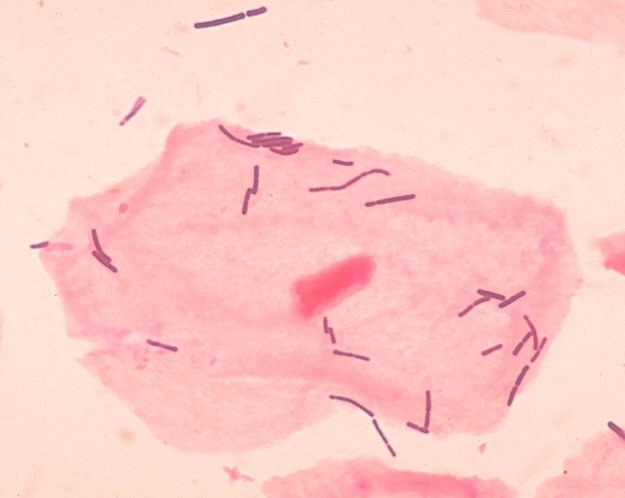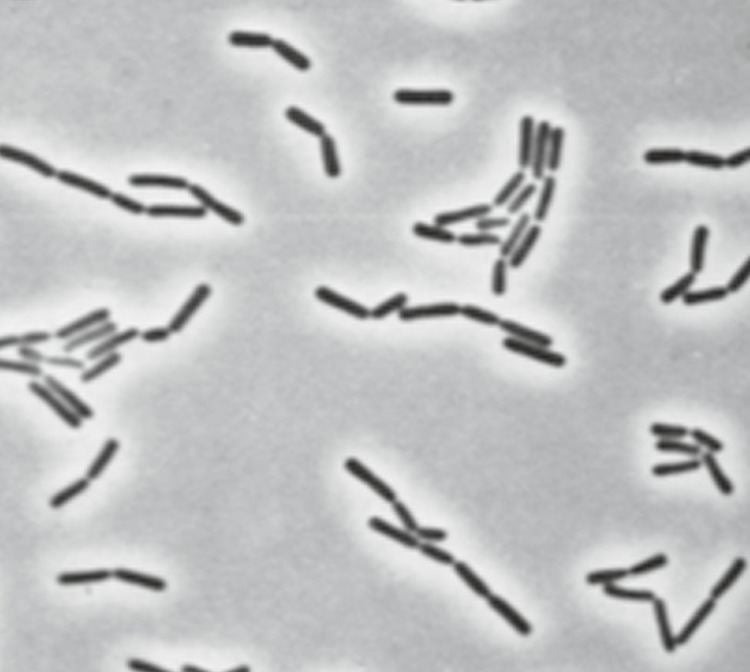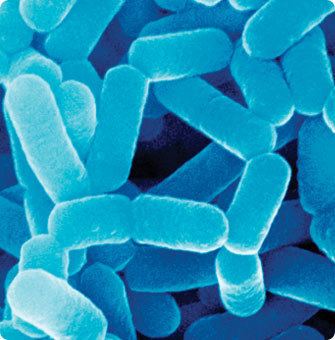Scientific name Lactobacillus Phylum Firmicutes Order Lactobacillales | Rank Genus | |
 | ||
Lower classifications Lactobacillus casei, Lactobacillus plantarum, Lactobacillus rhamnosus, Lactobacillus delbrueckii subsp bu, Lactobacillus reuteri | ||
Lactobacillus is a genus of Gram-positive, facultative anaerobic or microaerophilic, rod-shaped, non-spore-forming bacteria. They are a major part of the lactic acid bacteria group (i.e. they convert sugars to lactic acid). In humans, they constitute a significant component of the microbiota at a number of body sites. In women of European ancestry, Lactobacillus species are normally a major part of the vaginal microbiota.
Contents
- Milk to curd by lactobacillus bacteria microscopic view
- Metabolism
- Genome
- Taxonomy
- Vaginal tract
- Interactions with other pathogens
- Probiotics
- Oral health
- Food production
- References

Milk to curd by lactobacillus bacteria microscopic view
Metabolism

Many lactobacilli operate using homofermentative metabolism (they produce only lactic acid from sugars), and some species use heterofermentative metabolism (they can produce either alcohol or lactic acid from sugars). They are aerotolerant despite the complete absence of a respiratory chain. This aerotolerance is manganese-dependent and has been explored (and explained) in Lactobacillus plantarum. Many species of this genus do not require iron for growth and have an extremely high hydrogen peroxide tolerance.
Genome
The genomes of Lactobacillus are highly variable, ranging in size from 1.2 to 3.3 Mb (megabases). Accordingly, the number of protein-coding genes ranges from 1,100 to about 3,200 genes.

Lactobacillus contains a wealth of compound microsatellites in the coding region of the genome, which are imperfect and have variant motifs.
Taxonomy

The genus Lactobacillus currently contains over 180 species and encompasses a wide variety of organisms. The genus is polyphyletic, with the genus Pediococcus dividing the L. casei group, and the species L. acidophilus, L. salivarius, and L. reuteri being representatives of three distinct subclades. The genus Paralactobacillus falls within the L. salivarius group. In recent years, other members of the genus Lactobacillus (formerly known as the Leuconostoc branch of Lactobacillus) have been reclassified into the genera Atopobium, Carnobacterium, Weissella, Oenococcus, and Leuconostoc. More recently, the Pediococcus species P. dextrinicus has been reclassified as a Lactobacillus species. According to metabolism, Lactobacillus species can be divided into three groups:
Vaginal tract
The female genital tract is one of the principal colonisation sites for human microbiota, and there is interest in the the relationship between the composition of these bacteria and human health, with a domination by a single species being correlated with general welfare and good outcomes in pregnancy. In around 70% of women, a Lactobacillus species is dominant, although that has been found to vary between American women of European origin and those of African origin, the latter group tending to have more diverse vaginal microbiota. Similar differences have also been identified in comparisons between Belgian and Tanzanian women.
Interactions with other pathogens
Lactobacillus species produce hydrogen peroxide which inhibits the growth and virulence of the fungal pathogen Candida albicans in vitro and in vivo. Following antibiotic therapy, certain Candida species can suppress the regrowth of Lactobacillus species at body sites where they cohabitate, such as in the gastrointestinal tract.
Probiotics
Lactobacillus species administered as a single probiotic agent is of no benefit in people with irritable bowel syndrome or Crohn's disease. When it is administered in combination with other probiotics, may help people with irritable bowel syndrome, although in a minority of cases may cause negative side effects, uncertainty remains around which type of probiotic works best, and around the size of the effect. Lactobacillus and bifidobacteria probiotics can reduce clinical symptoms of pouchitis and cholangitis. L. acidophilus is used to prevent necrotizing entercolitis and other neonatal infections.
Oral health
Some Lactobacillus species have been associated with cases of dental caries. Lactic acid can corrode teeth, and the Lactobacillus count in saliva has been used as a "caries test" for many years. Lactobacilli characteristically cause existing carious lesions to progress, especially those in coronal caries. The issue is, however, complex, as recent studies show probiotics can allow beneficial lactobacilli to populate sites on teeth, preventing streptococcal pathogens from taking hold and inducing dental decay. The scientific research of lactobacilli in relation to oral health is a new field and only a few studies and results have been published.
Food production
Some Lactobacillus species are used as starter cultures in industry for controlled fermentation in the production of yogurt, cheese, sauerkraut, pickles, beer, cider, kimchi, cocoa, kefir, and other fermented foods, as well as animal feeds. The antibacterial and antifungal activity of Lactobacillus species rely on production of bacteriocins and low molecular weight compounds that inhibits these microorganisms.
Sourdough bread is made either spontaneously, by taking advantage of the bacteria naturally present in flour, or by using a "starter culture", which is a symbiotic culture of yeast and lactic acid bacteria growing in a water and flour medium. The bacteria metabolize sugars into lactic acid, which lowers the pH of their environment, creating a signature "sourness" associated with yogurt, sauerkraut, etc.
In many traditional pickling processes, vegetables are submerged in brine, and salt-tolerant Lactobacillus species feed on natural sugars found in the vegetables. The resulting mix of salt and lactic acid is a hostile environment for other microbes, such as fungi, and the vegetables are thus preserved—remaining edible for long periods.
Lactobacilli, especially L. casei and L. brevis, are some of the most common beer spoilage organisms. They are, however, essential to the production of sour beers such as Belgian lambics and American wild ales, giving the beer a distinct tart flavor.
